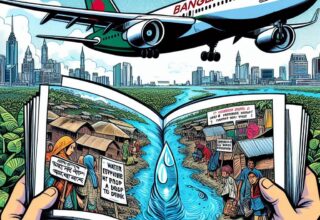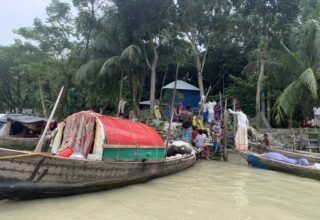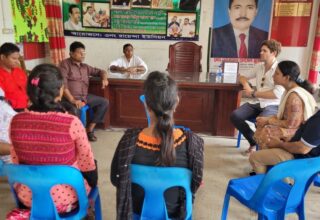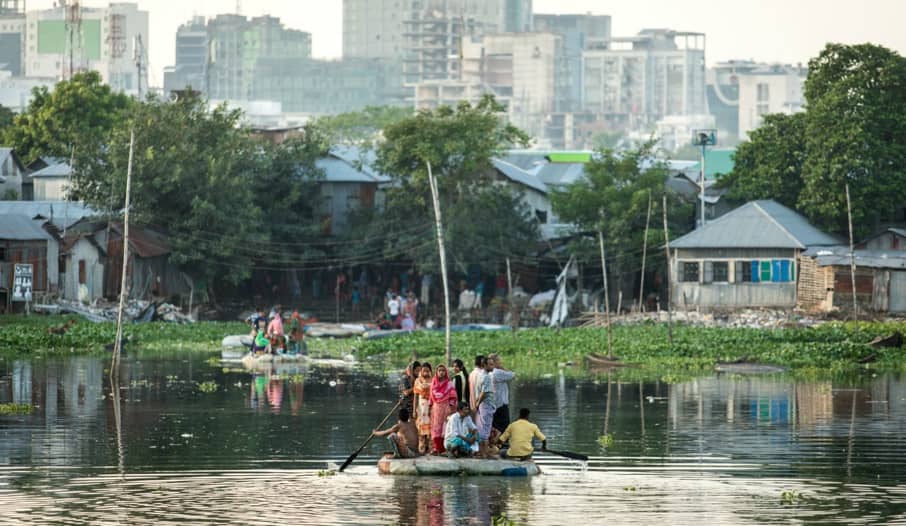
Last month, I had the chance to stay in Dhaka, the capital of Bangladesh. I could clearly witness the demographic boom happening in an already land and resource scarce overpopulated city. Having worked there for a local research centre, the International Centre for Climate Change and Development (ICCCAD), and having experienced local living conditions, I was able to witness the magnitude and intensity of climate change. This environmental threat leads to another human security issue: climate-induced migration. It qualifies individuals that are forced to migrate as a consequence of serious deterioration of their living conditions due to climate-related environmental change for a permanent or temporary period and on an internal or international scale. Climate change-induced migration is becoming increasingly important in Bangladesh, a country already considered as one of the most vulnerable to the climate emergency. As a result, this new migration phenomenon reveals many upcoming threats caused by climate change.
Climate migration, a global phenomenon on the rise
On a global scale, the phenomenon of climate migration is on the rise. Climate change is causing significant disruptions to traditional rain patterns, causing droughts and deluges, increasing flooding and riverbank erosion, and being a major cause of sea-level rise pushing salt water into coastal agricultural areas. The United Nations High Commission for Refugees (UNHCR) released its yearly studies on migration movements over the year [1]. In 2018, 41.3 million people were internally displaced worldwide. It includes 17 million people displaced as a result of climate change events [2]. In the future, the International Organisation for Migration (IOM) claims that an estimated 25 million to a billion individuals will become environmental internal or international migrants by 2050 [3]. Even if the current aims to limit the damage of climate change on the most vulnerable populations are met successfully, tens of millions will nonetheless suffer from impoverishment, inevitably leading to widespread displacement and hunger [4].
Bangladesh is an interesting case because of its vulnerability to these extreme climate events and the problems it will entail.
Bangladesh, a nation under threat
Bangladesh is especially vulnerable to climate change due to its geographical characteristics. As a matter of fact, its flat topography, dense population and weak infrastructure makes it exceptionally exposed to significant migration movements. It is prone to floods and droughts in the lowlands and storm ravages on the coastlines. This combination of vulnerability and threats could make climate change the country’s number-one driver of internal migration [5]. The coastline is considered as the most vulnerable area of Bangladesh as it is likely to be affected by rising sea-waters in the years to come. This situation means that the current coastline will eventually become uninhabitable, therefore causing loss of livelihoods and leading to mass-displacements [6].
While already experiencing an extremely important migration crisis with the Rohingya situation, the Bangladeshi geography makes the country particularly prone to new forms of migrations currently emerging and set to boom in the future. Internal environmental migration has always existed under the form of seasonal migration due to climatic stresses altering the employment stability in some Bangladeshi areas. According to the International Displacement Monitoring Centre, 952,000 people were forcefully displaced every year due to climate stresses over the last decade [2]. As explained by Henrietta Fore, UNICEF Executive Director, the phenomenon is only worsening: “climate change is deepening the environmental threat faced by families in Bangladesh’s poorest communities, leaving them unable to keep their children properly housed, fed, healthy and educated” [7]. Considering the already existing large-scale damaging effects of climate change, source of internal climate refugees’ movements, how can Bangladesh handle this worsening situation?
Bangladesh established a very clear Climate Change Strategy and Action Plan to become a climate resilient country by 2030. Nevertheless, climate change experts are worried that climate change-induced migration might interrupt the well-functioning of this plan. Yet, climate migration is not only a challenge, but rather a key stake to build up strong and sustainable resilience to climate change through good management.
Bangladeshi challenge: building up resilience through managing an upcoming climate refugee crisis
Due to its flat topography as a vast river delta, below sea-level and subject to extreme events, the life of the Bangladeshi population is directly at risk. Bangladesh is expected to lose up to 20% of its land by the end of the century due to rising sea levels [8]. The announced rise will put up to 27 million Bangladeshi lives at risk by 2050 [9]. These 27 million people will have to move to find refuge. The question remains what their destination will be. It has been proven that most of the existing Bangladeshi climate refugees took shelter in Dhaka [10]. The IOM claims that more than 70% of the people living in Dhaka slums moved there due to environmental challenges [11]. Nevertheless, the capital has already 47,500 people per square/km, which is twice that of Manhattan. It has therefore no means and capacity to welcome more climate migrants. The climate migration situation is therefore about to become a crisis and needs urgent management.
Climate migration, a Human rights issue that goes beyond environmental concerns
The consideration of climate refugees is also a matter of Human rights. The destinations of these migrants, most of the time, does not guarantee them to enjoy basic Human Rights. UNICEF points out that the number of people residing in Bangladeshi slums grew up by 60% in the past 17 years, many of them believed to be climate refugees [12]. This climate refugee crisis also includes the Rohingya crisis. Around 12 million Bangladeshi children struggle to have access to health clinics and to water safety as their infrastructures have been struck by powerful extreme events. Another 4.5 million children in coastal communities, including Rohingya camps, do not live in adapted infrastructures to resist against these events. Concerns over food security and education can also be raised in such living conditions. It is now clear that the climate refugee phenomenon is strongly correlated to the risk of deprivation of Human rights of many Bangladeshi communities, leading to an expected booming of climate migratory movements.
Despite Bangladesh having adopted an extremely ambitious resilience plan and already being considered as a leader in climate resilience by the international community, the rising issue of climate refugees’ rights implies that further large-scale measures must be taken, especially on an international legal aspect.
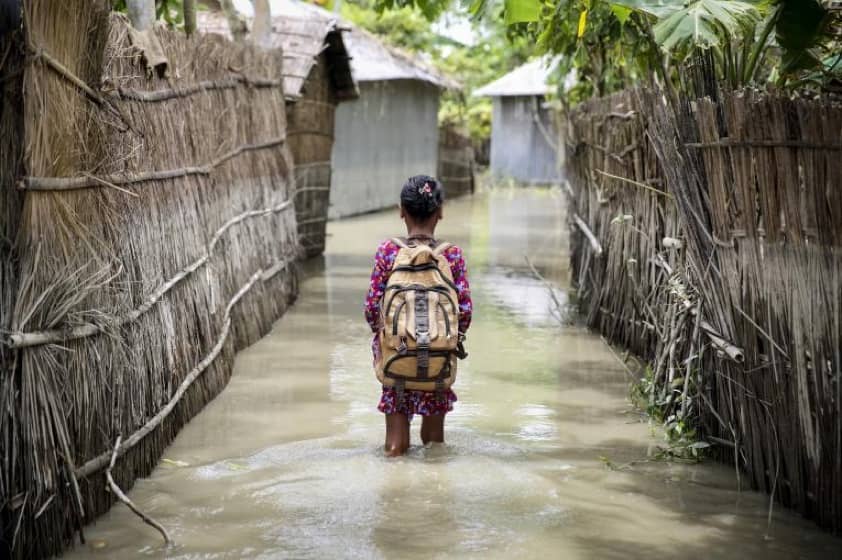
“huge numbers of people moving is perfectly possible. It’s their legal status that determines whether that episode of movement looks like a crisis or not. If you make it safe and legal, it stops being a crisis”Alex Randall, director of the Climate Change and Migration Coalition, 2019
Adapting international refugee law as a first step towards an inclusive migratory resilience plan
The 1951 Convention Relating to the Status of Refugees is the basis on which international refugee law is written. Nevertheless, because the existing legal framework was written in a period when the climate challenge was not known yet, climate change-induced migration is not legally recognised. The international community and the United Nations must now be urged to recognize people being displaced due to the deterioration of their habitat as a consequence of climate change. After losing their livelihoods, their only protection relies in Human rights law, guaranteeing universal rights to everyone. Given that the current and upcoming climate refugees face threats to their life and habitat, this phenomenon needs to be better addressed. Ignoring it by not giving them a legal status will not lead to a better management of the situation. There is an urgent need, as defended by the Environmental Justice Foundation [13], to finally accept “environmental migrant” and “climate refugees” as legal categorisations. This would inevitably lead to another question of accountability at the source of this climate migration, but the environmental refugee legal status is a first step to better prepare the announced large-scale migratory movements. As Randall said, “huge numbers of people moving is perfectly possible. It’s their legal status that determines whether that episode of movement looks like a crisis or not. If you make it safe and legal, it stops being a crisis”[15]. This legal adaptation is part of a global climate resilience progress and will very likely be discussed in the near future.
Climate migration as a tool for climate resilience and an opportunity for development
The key to better management of climate migration is also to transform this appearing threat into an opportunity to further develop a country like Bangladesh. The coastal economic area might be severely hindered by the climate migration movements, but others can benefit from it. The local research centre, ICCCAD, has suggested some solutions to prevent this from being considered as a crisis [14]. Researchers have identified some climate resilient small towns, that would also have the capacity to welcome migrants, making them “climate-resilient, migrant-friendly towns”. More than a million migrants could be moved to these towns in an attempt to solve the housing crisis in Dhaka and create better climate resilience. The solution might therefore rely on climate funds allocated to local projects and urban planning to better and smartly resettle migrants. Furthermore, another measure supported is the funding of coastal students to study in inland territories by providing scholarships. It is hoped that the family will follow, joining their children in climate-resilient towns. Other climate-resilient strategies and practices are being suggested to better manage the climate migratory phenomenon. As the migratory phenomenon is now inevitable, they should be considered as an opportunity rather than a threat.
Bangladesh therefore experiences an important internal refugee phenomenon, and this will be exacerbated by climate change, expected to push millions of people on the roads. Climate change events such as sea-level rises, changes in temperature, rain pattern disruptions and their consequences (loss of Human rights and others), will prompt large-scale climate migration. Despite having ambitious climate-resilience programmes, Bangladesh struggles to consider climate refugees, as there lacks exact numerical estimations and as it is an already extremely densely populated country. Local researchers are attempting to transform this migratory phenomenon in an opportunity for further economic development. Nevertheless, this needs to be supported by further developments of international refugee laws and protections, as the scale of these migratory movements will become global. By giving climate refugees a legal status, it will be easier to manage, categorize them and be prepared for future migrants, including Bangladeshis moving abroad. Nevertheless, it is not only law that will solve the issue. Rather than qualifying these migrants ‘environmental refugees’ or ‘climate refugees’, it should be considered as a transformational livelihood adaptation strategy to support resilience against climate change; because climate migration will be part of our world sooner than later, and it will be the cornerstone of global demographic dynamics.
Originally this blog was published on JULY 29, 2019 at Sensus Journal.
The Author:
Baptiste Moinier
Baptiste Moinier is a final year International Relations student at King’s College London. His particular interests of study include the impact of climate change on migration, sovereignty as well as climate resilience practices and strategies.
contact: baptiste.moinier@kcl.ac.uk

